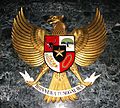National emblem facts for kids
A national emblem is a special symbol that officially represents a country. It can be an animal, a plant, or even an object. These emblems often appear on a country's flags, coins, or official documents. They help people recognize a country and often tell a story about its history or values.
Contents
Animals that Symbolize Countries
Many countries choose an animal as their national emblem. These animals often represent qualities like strength, freedom, or unique wildlife found in that country.
- Albania: The eagle
- Australia: The kangaroo and the emu
- Austria: The black eagle
- Bangladesh: The Bengal tiger (national animal), Oriental magpie-robin (national bird), and Hilsha herring (national fish)
- Belgium: The lion
- Bhutan: The takin
- Bolivia: The llama
- Brazil: The rufous-bellied thrush
- Canada: The beaver
- Chile: The condor and the huemul
- China: The giant panda and, historically, the dragon
- Colombia: The Andean condor
- Denmark: The lion
- Egypt: Saladin's eagle
- England: The lion
- Finland: The lion, whooper swan, and brown bear
- France: The Gallic rooster
- Germany: The black eagle
- India: The Indian elephant (national animal), peafowl (national bird), and Ganges Dolphin (national aquatic mammal)
- Indonesia: The Garuda (a mythical bird) and the Komodo dragon
- Japan: The pheasant and crane
- Mexico: The golden eagle
- Netherlands: The lion
- New Zealand: The kiwi
- Pakistan: The Markhor (national animal), Chukar (national bird), and Golden Mahseer (national fish)
- Philippines: The Philippine eagle and Carabao (water buffalo)
- Poland: The white eagle
- Russia: The bear and the golden two-headed eagle
- Scotland: The red lion
- South Africa: The Springbok Antelope
- South Korea: The magpie and the Korean tiger
- Spain: The Osborne Bull
- Sri Lanka: The lion
- United States: The American bald eagle
- Wales: The red dragon
People as National Symbols
Sometimes, a country is represented by a famous person, a historical figure, or even a fictional character. These figures often embody the spirit or values of the nation.
- Albania: Gjergj Kastrioti Skanderbeg (a national hero)
- Canada: Johnny Canuck (a cartoon character)
- France: Marianne (a symbol of liberty and reason)
- Germany: Deutscher Michel and Germania
- Hawaii: King Kamehameha the Great
- India: Bharat Mata (Mother India)
- Ireland: Erin and Hibernia
- Pakistan: Muhammad Ali Jinnah and Fatimah Jinnah (founding figures)
- United Kingdom: Britannia and John Bull
- United States: Uncle Sam and Lady Liberty
Plants that Symbolize Countries
Plants are also popular national emblems, often chosen for their beauty, importance to the country's ecosystem, or cultural significance.
- Argentina: The Ceibo flower
- Australia: The golden wattle
- Bangladesh: The Shapla (national flower) and Jackfruit (national fruit)
- Canada: The maple leaf
- China: The peony and mei blossom
- Hong Kong: The bauhinia blakeana
- Macau: The Lotus
- England: The red-and-white rose of Tudor
- Estonia: The blue cornflower
- France: The lily (historically)
- Germany: The oak
- India: The Sacred lotus (national flower) and Mango (national fruit)
- Ireland: The shamrock
- Japan: The chrysanthemum
- Malaysia: The Chinese Hibiscus
- Mexico: The dahlia
- Netherlands: The tulip
- New Zealand: The silver fern
- Pakistan: Poet's Jasmine (national flower) and Mango (national fruit)
- Philippines: The sampaguita (Arabian jasmine)
- Scotland: The Thistle
- South Africa: The king protea
- South Korea: The Hibiscus
- Switzerland: The edelweiss
- United States: The rose
- Wales: The daffodil and leek
Trees that Symbolize Countries
Trees are often chosen as national symbols because they represent strength, longevity, and growth.
- Albania: The Olive
- Bangladesh: The Strangler fig (national tree)
- Canada: The Maple tree
- Czech Republic: The lime tree
- Denmark: The beech tree
- England: The oak
- Germany: The oak
- India: The Indian banyan
- Japan: The Cherry blossom tree
- Lebanon: The Lebanon Holy Cedar
- Pakistan: The Cedrus deodara (Himalayan Cedar)
- Russia: The birch tree
- Scotland: The Scots Pine
- United States: The oak
- Vietnam: The bamboo
Inanimate Objects as National Emblems
Some countries use objects or landmarks as their national emblems, which can represent their history, geography, or cultural achievements.
- Armenia: Mount Ararat
- Australia: The southern cross (a star constellation)
- Cambodia: Angkor Wat (a famous temple complex)
- India: The Lion Capital of Ashoka (an ancient sculpture)
- Ireland: The Celtic harp
- Israel: The menorah (a candelabrum)
- Japan: The Sun (often depicted without rays)
- New Zealand: The southern cross
- Soviet Union: The hammer and sickle (symbols of workers and farmers)
- Sweden: The Three Crowns
- European Union: 12 yellow stars arranged in a circle
Other Important Symbols
Beyond animals, plants, and objects, many countries have abstract symbols or designs that represent them.
- Argentina: The Sun of May
- Australia: The Commonwealth Star
- Bangladesh: The Red Sun
- Canada: The Maple Leaf
- Croatia: The checkerboard pattern
- England: St George's Cross
- Germany: The Iron Cross
- India: The Ashoka Chakra
- Ireland: St Patrick's Cross
- Israel: The Star of David
- Pakistan: The Crescent and star
- Scotland: The Saltire or St Andrew's Cross
- South Korea: The Yin Yang symbol
- Switzerland: The Swiss cross
- Ukraine: The trident
Images for kids
See also
 In Spanish: Emblema nacional para niños
In Spanish: Emblema nacional para niños


